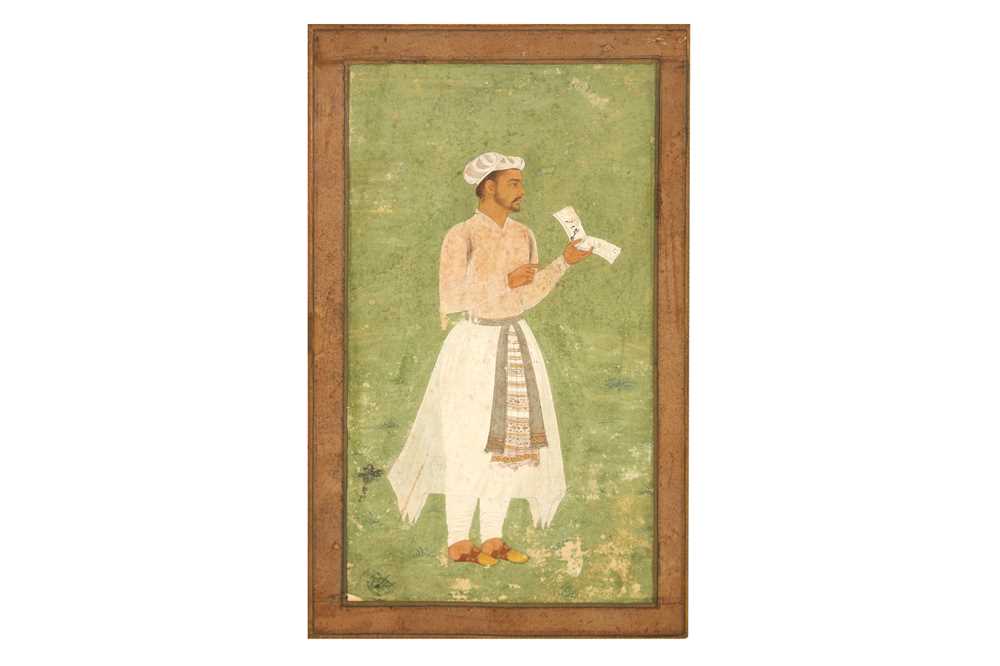28th Oct, 2022 14:00
Islamic & Indian Art
A STANDING PORTRAIT OF A MUGHAL COURTIER
Mughal India, ca. 1610 - 1620
A STANDING PORTRAIT OF A MUGHAL COURTIER
PROPERTY FROM A PRIVATE AMERICAN COLLECTION
Mughal India, ca. 1610 - 1620
Opaque pigments heightened with little gold on paper, the vertical composition depicting a standing portrait of a Mughal courtier holding a book, wearing a white fine muslin cotton robe over white pajamas trousers, around his waist a gold and silver thread-embroidered shawl used as a belt, set against a green vegetal background, mounted on a later album page with concentric polychrome borders in the tones of brown and red, 25.8cm x 19cm.
Provenance: Private French Collection; accompanied by the original purchasing invoice from Claude de Muzac gallery in Paris, dated 2 June 1977.
The accession to the Mughal throne of Salim as Jahangir in 1605 introduced profound changes in the royal workshops and their creations. Firstly, the studio was reduced to a much smaller number of renowned artists, whose names are often inscribed on album pages by the emperor himself in acknowledgment of their superb work. Secondly, a considerable shift in the subject matter was to be witnessed: the focus was no longer on large historical or poetical manuscripts, but rather on the observation of the world around the Emperor himself, meticulously recording exotic animals, beautiful flowers, important events in his lifetime, and portraits of himself and his acquaintances, especially his loyal advisors, courtiers, and attendants (J. P. Losty and Malini Roy, Mughal India: Art, Culture and Empire, 2012, pp. 80 - 83).
Portraiture was an art form of pivotal importance at the Mughal court, but before the Jahangiri period, Mughal portraits heavily relied on Iranian conventions. From the early 17th century onwards, a new aesthetic canon was inaugurated, introducing a meticulous approach to naturalistic portraiture to capture the likenesses of the sitters, allowing the Emperor to 'gauge their true character' (Emily Hannam, Eastern Encounters, 2018, p. 84). It is precisely thanks to this shift that some of the most accomplished Mughal portraits and calligraphy album were created by the masterful brushes of royal painters like Bishn Das, Govardhan and Manohar.
The present lot shows strong affinities with early 17th-century portraits attributed to Manohar (active ca. 1582 – 1624), the son of Basawan, one of the most celebrated artists at Emperor Akbar's court. A superb craftsman, punctilious portraitist, and animalier, Manohar grew up in the imperial workshops, where his style evolved side by side with the swiftly changing imperial canon (S. C. Welch, A. Schimmel and M. L. Swietochowski, The Emperors' Album: Images of Mughal India, 1987, see nos. 16, 18 & 24). Our sitter is presented against a light green ground wearing a distinctive diaphanous four-pointed (chakdar) white cotton jama, a robe that went out of fashion at the imperial court toward the end of the sixteenth century. The same attire and apple-green ground can be seen in the "Portrait of Prince Danyal", attributed to Manohar, on a folio from the Shah Jahan Album in the Metropolitan Museum of Art collection (acc. no. 55.121.10.32). Another portrait attributed to this painter and part of the same album at the MET, "Portrait of Zamana Beg, Mahabat Khan", features the same stylistic choices of green ground and profile stand (acc. no. 55.121.10.3). To determine if the present portrait was painted by Manohar himself or one of his acolytes, further research is required. Nevertheless, the colour scheme, the compositional arrangement, and the physiognomical naturalism in the depiction of the courtier's face suggest an undeniable link between this lot and early 17th-century Jahangiri album portraits.
Sold for £1,750
Includes Buyer's Premium
Do you have an item similar to the item above? If so please click the link below to submit a free online valuation request through our website.




